
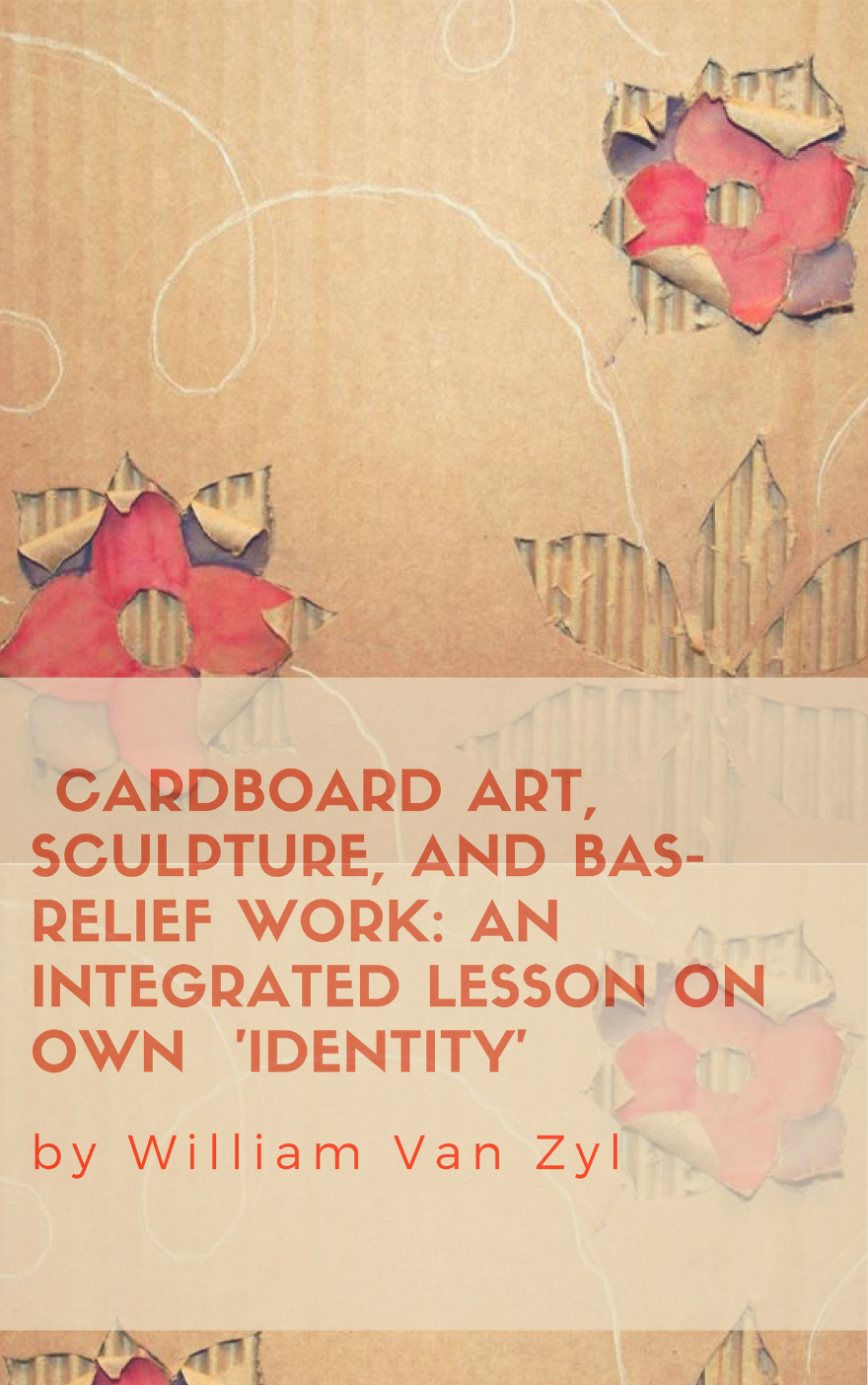
Front cover.
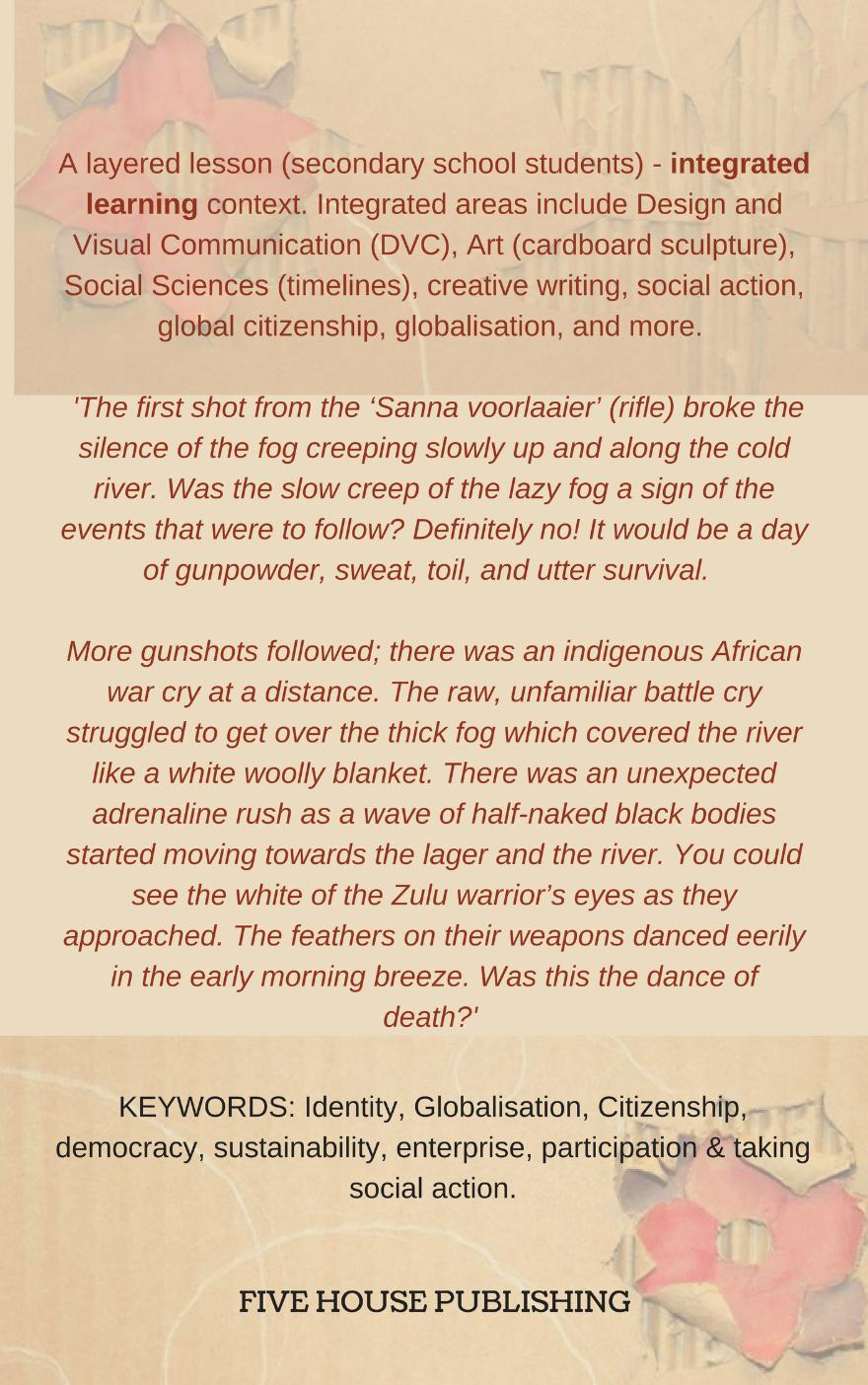
Back cover. Available at fivehousepublishing.com
By William Van Zyl ( First published in 2017, edited in 2018 & 2024)
Table of Contents
The Battle of Bloodriver
The first shot from the ‘Sanna voorlaaier’ (rifle) broke the silence of the fog. It crept slowly up and along the cold river like a thick blanket. It was an uncertain, nervous bang.
Was the slow creep of the lazy fog a sign of the events that were to follow? Definitely not! It would be a day of gunpowder, sweat, toil, and utter survival.
More nervous single gunshots followed; there was an indigenous African war cry at a distance. The raw, unfamiliar battle cry struggled to get over the thick fog which covered the river like a white woolly blanket. There was an unexpected adrenaline rush as a wave of half-naked black bodies started moving towards the lager and the river. As they approached, you could see the anxious white of the Zulu warrior’s eyes. Tied to their weapons with strong strips of raw bark, the feathers danced eerily in the early morning breeze. Proud Leopard skin covered parts of their muscular bodies. Nimble and agile, they wove through the bush, heading towards the lager-like cheetahs stalking their prey.
Was this the dance of death?
The ‘ossewa’ (wagons) were woven into a large wreath that contained and embraced the Afrikaners’ faith, belief, and courage. The Boers were now aiming with their long shots – waiting for the Zulus to get closer.
Would the Afrikaners survive the onslaught of the Zulu’s?
A cloud of gunpowder billowed from the barrels of the rifles as the battle heated up. At the break of dawn. the familiar ‘boom’ sound of traditional 1830’s long rifles filled the ears of everyone – men, women, and children. The Boer war machine worked like a well-oiled conveyor belt. Firing – then filling the barrel with gunpowder – ramming – dropping a ball into the barrel – ramming it down the barrel with a rod – and fire. Again, and again. Frantically, the men, women, and children loaded the rifles by continuously ramming gunpowder and small lead balls into the barrels. Their lives were at stake.
“Quickly, load, they are coming!” rang the voices of the Afrikaners in the lager.
The sun’s first light was shocked at the battle scene – surprised by the contrasts of the weapons used – it gasped at the ‘trains’ of Zulu warriors moving towards the boer lager. The sharp, long ‘assegai’ points flashed ghastly in the morning light as the warriors ran toward the Afrikaner lager – wave upon wave. The ‘knobkieries’ swish-swashed through the air as the Zulus gained momentum. Determined, they ran toward the tight-knit boer lager.
Would the ‘ossewa’ wagons and the rifles of the Boers keep the Zulus at bay? The Afrikaners were outnumbered by far!
The Covenant they have made with God – would it protect them?
The result?
About 10,000-20,000 Zulu warriors led by Dingaan’s generals Dambuza (Nzobo) and Ndlela kaSompisi attacked the Voortrekkers, but the 470 Voortrekkers, with the advantage of gunpowder, warded them off. The battle began at dawn and was over by midday. More than 3000 Zulu casualties were counted around the laager. The boers triumphed on the day.
TRANSLATED INTO AFRIKAANS (AANVANKLIK DEUR CHATGPT VERTAAL – DAARNA VERFYN DEUR DIE SKRYWER):
Die Slag Van Bloedrivier.
Die eerste skoot van die ‘Sanna voorlaaier’ (geweer) het die stilte van die mis deurboor. Dit het stadig opgeskuif en langs die koue rivier gekruip soos ‘n dik wol kombers. Dit was ‘n onseker, senuweeagtige knal.
Was die stadige skuif van die wit mis ‘n teken van die gebeure wat sou volg? Beslis nie! Dit sou ‘n dag wees van kruiddamp, sweet, moeite, en absolute oorlewing.
Meer senuweeagtige enkelgeweerskote het gevolg; daar was ‘n inheemse Afrika-oorlogskreet in die verte. Die rou, onbekende oorlogskreet het gesukkel om deur die digte mis te kom wat die rivier soos ‘n wit wollerige kombers bedek het. Daar was ‘n onverwagte adrenalien-vloei toe ‘n golf van halfnaakte swart liggame na die laer en die rivier beweeg het. Jy kon die angstige wit van die Zulu-kryger se oë sien terwyl hulle nader kom. Die vere – vasgemaak aan hul wapens met sterk repies van rou bas – het spookagtig gedans in die vroeë oggendbries. Trotse luiperdvel het dele van hul gespierde liggame bedek. Ligvoetig en rats het hulle deur die bos beweeg – nader, en nader aan die laer – soos jagluiperds wat hul prooi bespeur.
Was dit die dans van die dood?
Die ‘ossewa’ (waens) was in ‘n groot ronde krans geweef wat die geloof, oortuiging, en moed van die Afrikaners bevat en omhels het. Die boere het nou gemik met hul langgewere – waggend vir die Zulus om nader te kom.
Sou die Afrikaners die aanval van die Zulu’s oorleef?
‘n Wolk van kruiddamp het uit die lope van die gewere geborrel. Die geveg het hewig geraak. Met die koms van die dag het die bekende “boem” knal van tradisionele 1830’s langgewere die ore van almal gevul – mans, vroue, en kinders. Die boere-oorlogsmasjien het soos ‘n goedgesmeerde konvêrteerband gewerk. Skiet – vul die loop met kruid – stamp kruid in die loop af – laat val ‘n koeël in die loop – stamp dit styf vas met die laaistok – en vuur. Weer en weer. Gedetermineerd het die mans, vroue, en kinders die gewere gelaai deur onophoudelik kruid poeier en klein loodballetjies in die lope af te stamp met die laaistokke. Hul lewens was op die spel.
“Vinnig, laai, hulle kom!” het die stemme van die Afrikaners in die laer geklink.
Die eerste lig van die son was geskok deur die skouspel van die geveg – verras deur die kontras van die wapens in die geveg – gewere versus spiese. ‘Treine’ van Zulu-krygers het na die boerelaer gevleg. Die skerp, lang ‘assegaai’-punte het afgryslik in die oggendlig geflits. Die Zulu krygers het na die Afrikaner-laer gehardloop – golf na golf. Die ‘knopkieries’ het deur die lug geswaai terwyl die Zulus momentum opbebou het. Vasberade het hulle na die diggesnoerde boerelaer gehardloop.
Sou die ‘ossewa’-waens en die gewere van die Boere die Zulus op ‘n afstand hou? Die Afrikaners was vêr oortref deur die getalle van die Zulus.
Sou die Verbond wat hulle met God gemaak het, hulle beskerm?
Die eindresultaat?
Ongeveer 10 000-20 000 Zulu-krygers, aangevoer deur Dingaan se generaals Dambuza (Nzobo) en Ndlela kaSompisi, het die Voortrekkers aangeval, maar die 470 Voortrekkers het, met die voordeel van kruiddamp, hulle afgeskrik. Die geveg het met eerste lig begin en was teen die middag verby. Meer as 3000 Zulu-slaggoffers is om die laer getel. Die boere was triomferend op die dag.
Dit word beweer dat die Zulus het die aand voor die geveg a trapleer met verligte wesens (engele?) gesien het wat op en af geklim het tot in die laer van die boere. Die wesens het skynbaar vanuit die ‘hemel’ afgeklim tot in die boerelaer. Op daardie punt was die boere besig of n verbond met die Vader te maak. Die volgende dag was die boere oorweldig deur die hoë getalle Zulus wat hulle aangeval het (470 boere versus 10,000 to 20,000 Zulus).
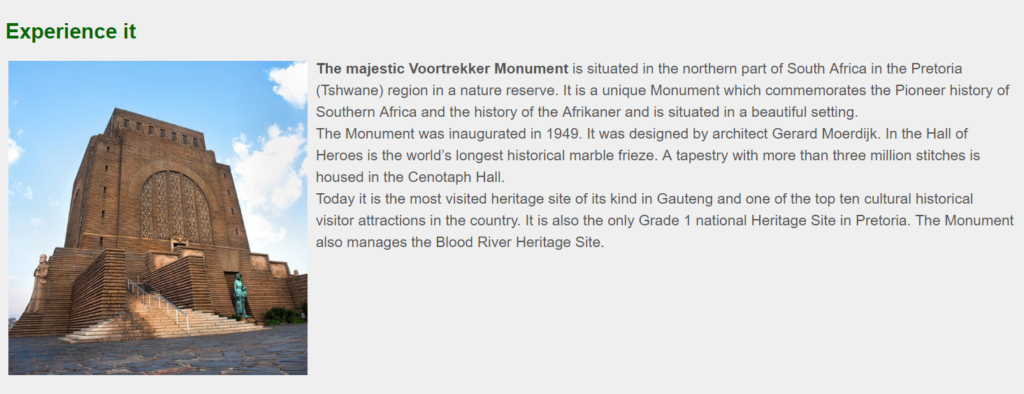
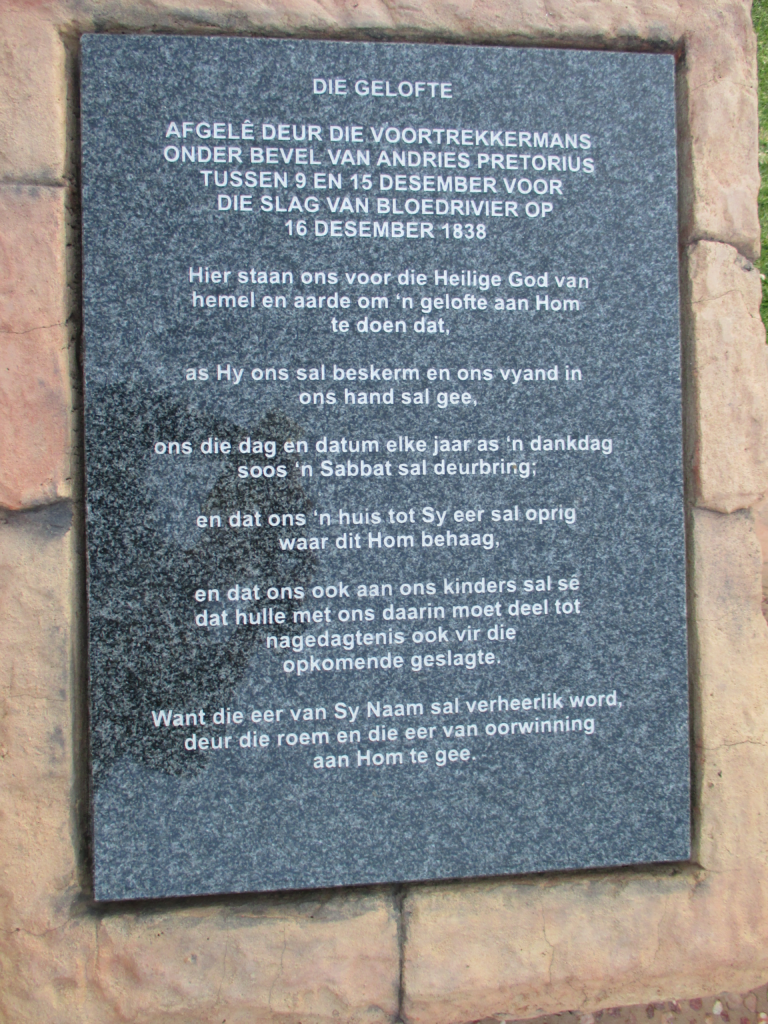
FOTO: Die gelofte buite die monument – teen die muur. Krediet: https://upload.wikimedia.org/wikipedia/commons/d/d4/Die_Gelofte_VoortrekkerMonument.JPG
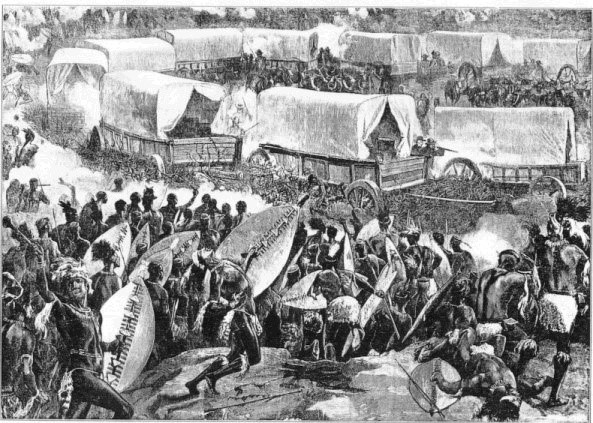
An artist’s impression of The Battle of Bloodriver. Credit: https://en.wikipedia.org/wiki/Battle_of_Blood_River
Product/article details (eBook format):
Resources for teachers and students: 64 pages with over 7000 words, including many images and video links. It also includes examples of bas relief work (cardboard art). A very inexpensive methods (artwork) to use in school or at home (home schooling). We all have cardboard at home in the recycling bin!
Subject focus: Art, Design and Visual Communication (Bas Relief work), Creative Writing, Education for Sustainability, Global Citizenship, Social Sciences, Spirituality, Maths, Physics, Enterprise, and more.
Keywords:
Battle of Bloodriver, art, bas-relief, cardboard art, cardboard sculpture, creative writing, Design and Visual Communication, Global Citizenship, identity, inquiry-based learning, integrated learning, STEAM education, STEM education, Sustainability, taking social action, timeline culture, enterprise, digital tools (timelines)
See products to download: https://fivehousepublishing.com/product/cardboard-art-sculpture-and-bass-relief-work-an-integrated-lesson-on-own-identity/
Excerpt:
Situation:
You are interested in cardboard bas-relief work. You want to express your ‘own identity’ linked to your culture, history, and your family. You intend to create artwork that will tell a story about who you are. Include your future dreams and plans!
Once your artwork is complete type up a short story about who you are, where you are from (your roots), something about your culture, and more. Be creative! There are no restrictions and limitations on your choice of artwork or your story. Remember it has to reflect your identity!
DESIGN BRIEF:
Design a bas-relief cardboard work of art that reflects your identity, your roots, your culture, your dreams and future. Once you have completed your inquiry, research, and artwork, type up the story of who you are. Include a timeline of the events you are describing (dates/years, etc.).
Take photographs of your artwork and use these illustrations to tell your story.
Use any method chosen (digital or paper) to develop your IDENTITY presentation. Include different ‘layers’ like your passions, your concerns, hopes and dreams. See the rest of this lesson which will guide you on how to develop a layered presentation. Important: start asking questions (inquiry). See the section on Inquiry-based learning! Think of yourself as global citizen!
SPECIFICATIONS:
- Size of corrugated cardboard: about 300 x 300 mm
- Use a craft knife or Exacto knife. Please be very careful when using it!!
- Storyboard/poster/display: Take a picture of your completed artwork on ‘IDENTITY” and paste it into a Google Slide. Provide a title and type up a short story on your IDENTITY and the work you have created. You may use several slides. Be creative!
- Timeline: The timeline of the events you are describing is your choice. You could consider an infographic or any other ‘timeline’ illustration of your choice. Check out canva.com (infographic) online graphic design website!
What is a timeline?
A timeline is a graphical representation of a period of time, on which important events are marked. Use a timeline to illustrate the dates and times of your story (“Identity”).
Contents:
Cardboard Art, Sculpture, and Bas-Relief work: An integrated lesson on ‘identity.’ Page 3
The Battle of Bloodriver. Page 4
This is how the teacher would start his story on his ‘IDENTITY’ as a South African. See the section on exciting and practical techniques to adapt fiction for nonfiction. 5
THE DVC LESSON: CARDBOARD ART – REFLECTING IDENTITY (OWN, CULTURE OR REGION). 8
‘RELIEF’ – CARDBOARD – ARTWORK. 8
DESIGN AND VISUAL COMMUNICATION LESSON (INTEGRATED LEARNING): “MY OWN IDENTITY – RELATED TO MY WORLD” (Junior DVC Students – Year 9 & 10 – New Zealand). 13
Situation: 13
DESIGN BRIEF: 13
SPECIFICATIONS: 14
What is a timeline?. 14
Ideas from High School Students. 15
KEYWORDS: Globalisation, Citizenship, democracy, sustainability, enterprise. Consider: Participation & taking action. 18
For example:. 18
ACCOUNTING AND NUMERACY: 22
Ca$h course for Kiwi kids: A new financial literacy app for schools gets kids earning money and paying taxes – virtually 24
TAKING RESPONSIBILITY, TAKING ACTION, AND DOING SOMETHING CONSTRUCTIVE: 24
SUGGESTION ON HOW YOU AND YOUR CLASS COULD TAKE ACTION TO ERADICATE POVERTY: 25
ADDITIONAL IDEAS TO MAKE A DIFFERENCE ARE: 26
ALTERNATIVE APPROACHES: Exploring Identity. 29
Inquiry-based learning. 32
Some inquiry question student could ask about their ‘IDENTITY’: 33
Students could consider the following methods to present their IDENTITY presentation (digital or on paper): 34
VIDEO CLIPS: Bas-Relief Artwork – Cardboard. 34
https://youtu.be/XBdSKmognjg. 35
Marking Schedule. 35
Exemplar: “What Mr Van Zyl (DVC teacher) will consider when he tells about his identity as a South African.” 36
Mr Van Zyl’s preparation of his ‘Ossewa’ (waggon) bas-relief for telling his story about his IDENTITY. Below are the different stages of the artwork: 38
Student work: 39
Tips on how to write exciting and compelling nonfiction. 39
Mr Van Zyl (Teacher) strategy: will start the story of his identity with the Battle of Bloodriver (South African History). He will explore creative writing in his introduction – he will endeavour to “hook” the reader in with an innovative introductory story (The Battle of Bloodriver). 39
- Tell a memorable story. 40
- Bait your audience. 40
- Use emotional language. 41
- Say it simply. 42
- Surprise the reader. 42
Online Timeline Creator. 43
Suggested layout and structure of your presentation. 44
- Introduction: 45
- A short overview of identity: 45
- Artwork – bas-relief cardboard – symbolism: 46
- Interesting facts about Mr Van Zyl and his family members: 46
Something that could interest you: 46
Use inquiry techniques and research to create depth in your presentation. 49
- Timeline: 49
- Global Citizenship, democracy, sustainability, and enterprise. Participating and taking action: 50
- Conclusion: 50
Notes to students: 50
How would Mr van Zyl tell his story and share his IDENTITY?. 51
So, what could a Maori student’s IDENTITY look like?. 51
About the ‘Puhoro’ (Maori context) of the College: 52
What could a Fijian student’s IDENTITY include?. 53
Be creative and innovative!. 55
Notes to teachers: Focus of the unit of work- INTEGRATED LEARNING.. 56
The focus:. 56
What is Interdisciplinary and Cross-curricular learning?. 58
What is integrated learning?. 58
Why an integrated language unit?. 59
How will integrated teaching and learning impact ‘NESB’ (NON-ENGLISH SPEAKING BACKGROUND) students? 59
More on identity (writing poetry): 60
Excerpt: 62
About the teacher. 62
Writer’s profile: 62
See more at. Page 63